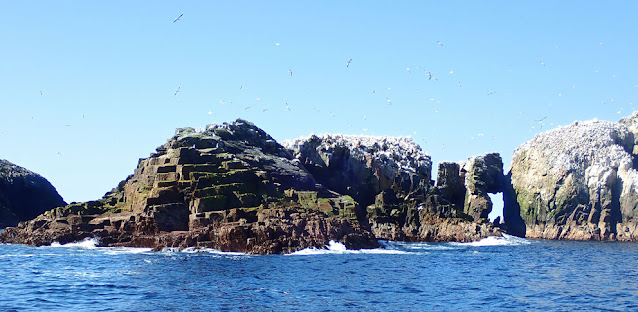The Continuing Adventures of Hjalmar Bjorge
Season 5 - Episode 5 - Mingulay to Mull
Exploring the Isles of the West Cruise April 18-May 2, 2022
From Mingulay we motored across the Sea of the Hebrides to Heisker Rock, where we were delighted by the sight of two minke whales. Peter Hill, author of Stargazing: Memoirs of a Young Lightkeeper, ends his book with a description of his last posting, which was on Hyskeir in 1973. Upon arriving via helicopter, he was greeted by the keepers, along with three other residents of his new posting.
And as we walked across the black lava towards the tallest lighthouse tower I had ever seen, three goats emerged out of the fine sea mist.
There have been no men (or goats) on Hyskeir since it was automated in 1997. (For more on Hyskeir see these posts: https://marccalhoun.blogspot.com/2014/11/scenes-from-heisker.html). The sea was mirror calm as we left Hyskeir and motored over to the west side of beautiful Canna, where we were planning to spend the night. The western cliffs of Canna were teeming with seabirds.
.
Once ashore I led the group to Rhu Church, also known as the Rocket Church due to its Irish Round tower belfry. It is always a delight to see it, especially on a bright spring afternoon with only wispy clouds floating overhead.
We then headed into the woodlands past John Campbell's grave to reach the Celtic Cross and the burial ground. Campbell's elegant tombstone reads:
Ian Latharna Caimbeul
1.10.1906 25.4.1996
Fear Chanaidh
Campbell died in Italy in 1996, and was buried there. But his body was returned to Canna in 2006. For the story of Campbell's life see The Man Who Gave Away His Island, by Ray Perman.
Our next stop was the bridge to Sanday, where some of us climbed to the high ground overlooking Sanday village. Just to the right of centre in the next photo you can see the Sanday Schoolhouse. The school dates to 1878, and is the subject of Kate Riley's book Canna School Days: https://acairbooks.com/product/books/non-fiction-books/history-non-fiction-books/canna-schooldays/
Just before returning to the ship a detour was made to Canna Prison. It is a mini-castle atop a dramatic stack that rises 80 feet above the western shoreline. The structure looks very precarious. I'd climbed it in my younger days, but not wanting to be responsible for the whole thing to come tumbling down, we settled for the view from below.
A fanciful watercolur of the prison was done by Richard Doyle in the 1870s. He titled it 'The Witches' Home'. No witches were soaring about, just curious gulls and kittiwakes.
When we returned to Hjalmar Bjorge we discovered Charlie had acquired prawns from a local fisherman. They made a delicious starter to the evening meal.
Overnight the weather drastically changed for the worse. We needed a place to shelter for the night, so Charlie took us over to the northeast corner of Ardnamurchan, where we anchored in Kentra Bay. In the morning we spent a couple hours ashore exploring the Singing Sands of Kentra. Similar to the Signing Sands of Eigg and Islay, if you scrape your shoes across the sands they make an odd, squeaking sound. Writing in 1844, the geologist Hugh Miller thought highly of the sound:
I walked over it, striking it obliquely at each step, and with every blow the shrill note was repeated. My companions joined me; and we performed a concert, in which, if we could boast of but little variety in the tones produced, we might at least challenge all Europe for an instrument of the kind which produced them.
A few of us made a stunning woodland walk above the sands, which starts with a warning sign about unexploded munitions in the sands. (Now they tell us!)
Fortunately, no one was blown up. (That would not have looked good on my Island Guider CV.) And so from Kentra we made our way to the Cairns of Coll, a spot known for whales. We did not see any whales, but we did see something fantastic - something in my thirty-plus years of Hebridean sailing I'd never seen. For over an hour, a large group of bottlenose dolphins bow surfed, and raced alongside the ship. There must have been nearly three dozen of them, gleefully playing with us, and you could tell they were happy to make us smile.
We ended the day on the pontoons of Tobermory Harbour. As we arrived I saw the sailing yacht Zuza tied up. She is a ship of memories for me. Many years ago I'd sailed on her around the Inner Hebrides and the Orkneys with Skipper Tim Wear at the helm.
After a wander around the village we spent the night on the pontoons, then got an early start back to Oban in the morning.
By noon the next day, we were in Oban to say our goodbyes. It had been an exemplary trip, and we'd been blessed with (mostly) magnificent weather. I want to thank Charlie, Mel, and Steve for being a great crew, and Peter, Liz, Anne, Nigel, Clare, Wolfgang, and Debbie for being such great travelling companions. I hope to sail with you all again, someday.























































